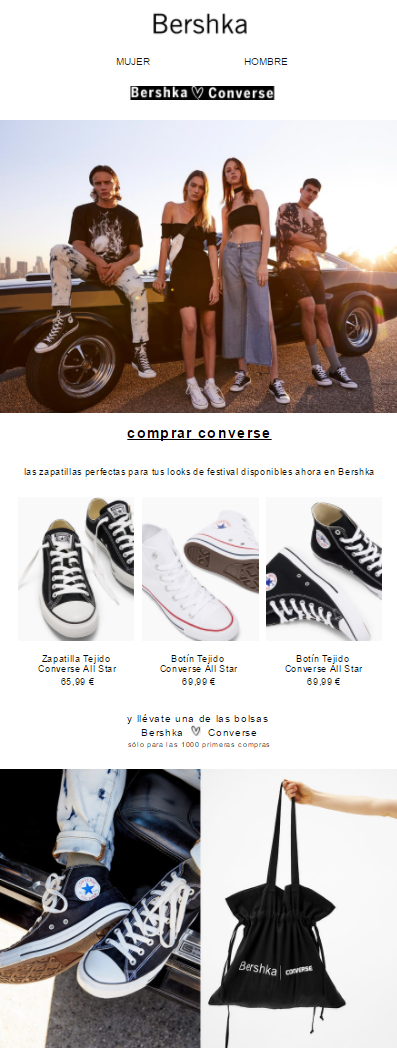5 email marketing campaigns that every ecommerce must have

If we look at all the emails we receive from the brands we follow, we will notice that there are different types of campaigns that are repeated in all of them, that is, among all the emails received, we could make subgroups or categories that would have common features and would seek the same goal. Each and every one of these types of campaigns are part of the email marketing strategy of an ecommerce, or at least, those that everyone should include. Today we will see the five most prominent:
1. Promotional campaigns
The promotional campaignsas the name suggests, are those which are characterised by offer the subscriber a discount to be redeemed via a code on the ecommerce site. They have a marked component of an offer that is about to expire in order to generate urgency in the receiver. If they have the feeling that the promotion is slipping through their fingers because it has a certain duration or because there are limited units, a much more instinctive purchase reaction will be created in them. The following features can be detected in this type of campaign:
- Mention of the promotion in the subject line
- Promotion between a 10% - 30%
- Limited duration
- Aggressive call to actions
- Promotion redeemable with a code
Below are 3 examples of promotional emails from the brand. Desigual. They are part of the same promotional campaign and were sent on different days.



2. Product campaigns
In the product campaignsIn contrast to the promotional ones, the product is the 100% protagonist. Therefore, the promotional element disappears and the the focus is on presenting the product's attributes, suggesting uses and contextualising it for the season.. Among the elements of this type of campaign we would find:
- Presentation of new products
- Specific product categories or typologies
- Trends and tips
- Less aggressive call to actions
The email from Bershka The following is a clear example of a product campaign. It focuses on a single garment, shows it from different perspectives (with and without a model) and provides information of interest to the subscriber (prices, models, colours) so that they are aware of its existence in the shops.

3. Brand campaigns
The brand campaignsUnlike the previous two, they do not focus so much on the brand's products, nor do they seek the objective of getting a reaction from the subscriber that leads to a purchase in the ecommerce. In this case, the emails are more corporate and seek to impact the user's view of the brand and its products.. They usually have the appearance of a product catalogue where the essence of the brand in its pure state is revealed. In this type of campaign we would find the following elements:
- Absence of prices
- No or very passive call to actions
- Clean, catalogue-like aesthetics
- More corporate than marketing objective
In this email from Handle which we can see below, we can see how the aforementioned features are fulfilled. It has the aesthetics of a catalogue and the focus is not so much on the products, but on the type of brand that Mango is and what it offers.

4. Targeted campaigns
When we talk about targeted campaignswe refer to those that are addressed solely and exclusively to one or a few subscribers. They aim to get reactions from the users who receive it. For example, you can send segmented campaigns to each group of subscribers who are in each of the phases of the Customer Life Cycle of a brand. So, for example, those in the reactivation phase would be sent a segmented campaign seeking a reaction of interaction with the brand. Another example would be the remarketing emailswhere we would look for a specific user to recover the cart that was abandoned in the ecommerce. And a final example, which we can also see below, would be the case of the birthday emails. Yes, such emails are also targeted campaigns and have a clear objective: to build customer loyalty through an attractive discount or a free gift.
In summary, we could say that targeted campaigns have the following characteristics:
- Personalisation
- Incorporate elements that are 100% in the subscriber's interest
- They seek a type of reaction from the user or group of users.

5. Campaigns for special dates
Campaigns that are planned and sent when an important date is approaching are among those that generate the most opportunities for brands. It is a widespread practice to take advantage of a special date in the calendar as an opportunity for brands. Valentine's DayChristmas, Christmas, Mother's Day... for conducting commercial campaigns and generating sales. Being in the minds of our subscribers when we know that a date is approaching where consumerism is triggered, is extremely important. If we give them ideas and convince them that we have the right gift, we will be much closer to generating a conversion.
This typology of emails has the following elements:
- Cases in which the name of the date is indicated
- Gift ideas
- Attractive discounts
- Aggressive Call to Actions
An example of this can be seen below:
